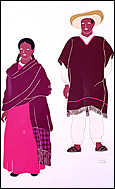

Movement
“The Indian”
Scenes, 1927. Carlos Mérida (Guatemalan, 1891-1984). Paris. Lithographs: 15" x 20". Purchased with funds given by Carol Nizzi Warmbold in memory of her husband Ted and Friends of Contemporary Art.
In the 18th century, Casta paintings were immensely popular. They were a series of idealized family portraits that portrayed the complex process of racial mixing or mestizaje, among Indians, Europeans, and Africans. Though Casta paintings were commissioned by church and government officials anxious to maintain clear social and racial boundaries, they signaled the changing demographics in the Americas that made maintaining such boundaries increasingly complicated.
Following the struggles for independence in the early 1800s, Latin American artists turned to the past for symbols of national resistance. Historical scenes were painted in European academic styles that made pre-Conquest Indian leaders look like noble Roman senators or classical heroes. Interest in the Indian as symbol did not, however, translate into concern over the actual conditions of oppressed and marginalized Indian populations.
With the advent of the Modern Era in the 20th century, Indian themes in art were frequently used as a means to articulate social protest or promote national unity. The Mexican muralist David Alfaro Siqueiros portrayed poor Indians to emphasize oppressive social conditions. Likewise, Ecuadorian artist Oswaldo Guayasamín (b. 1919, Quito, Ecuador) represented Indians in terms of social protest. In Peru, José Sabogal was a proponent of indigenism in painting in Peru in the 1920s and 1930s. He painted Indian figures as representatives of the glorious Inca past and symbols of cultural unity. At the same time, his figures served as reminders of unjust laws that robbed indigenous families of their ancestral lands.